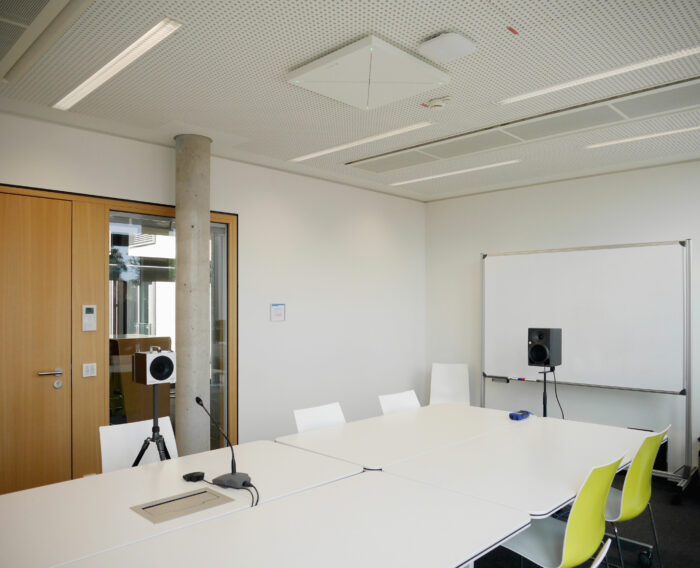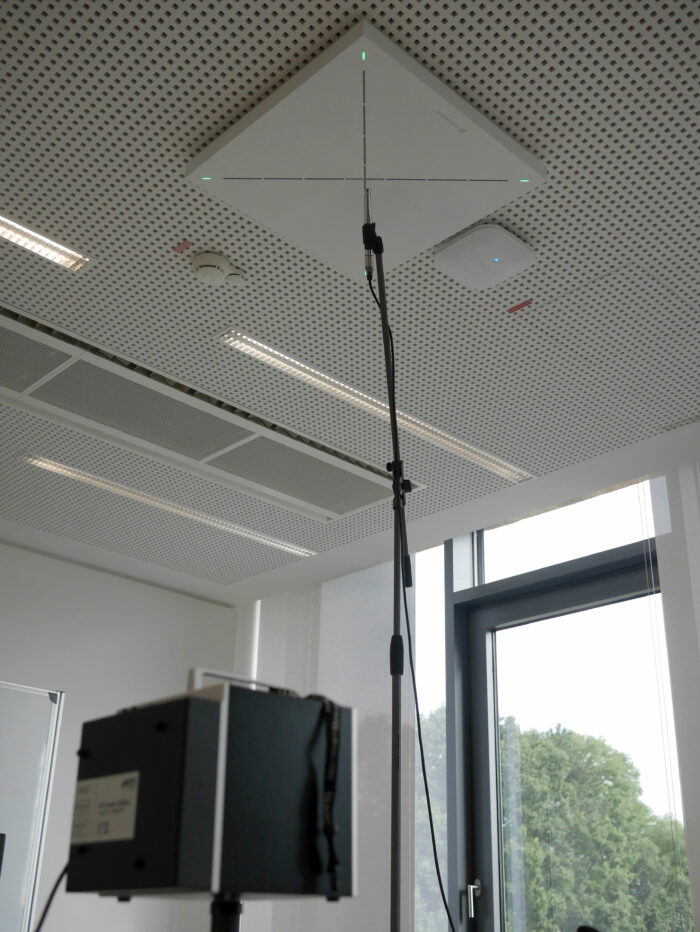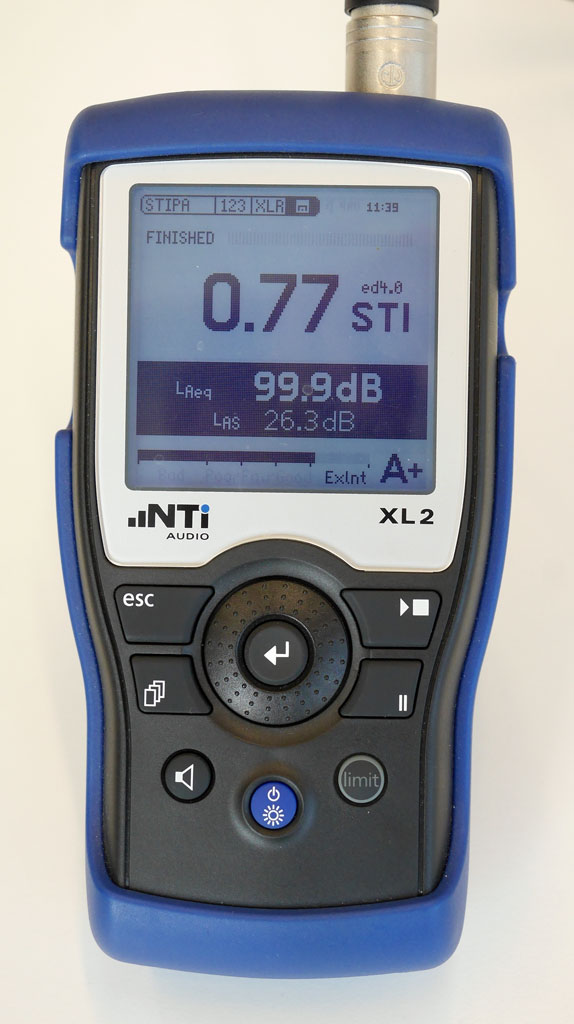Fast Chaser

Adaptive Array Microphone Sennheiser TeamConnect Ceiling 2
When I look at the latest technical developments in the microphone sector presented at recent (read: before Corona) trade fairs such as ISE, IBC or ProLight+Sound or at conferences such as Tonmeistertagung or ICSA (Int. Congress on Spatial Audio), I have the distinct impression that so-called array microphones could be “The next big thing”, as they say. A great advantage of array technology is that the directional characteristics of such a microphone array can be influenced within wide limits by purely electronic means, provided that one is willing to use enough microphone capsules and to make the necessary signal processing effort. The reward is a microphone system that can be used very flexibly and often makes a considerable number of classic microphones superfluous. This is precisely the purpose of Sennheiser TeamConnect Ceiling 2, which is designed to greatly simplify the miking of a conventional discussion system, for example for video conferencing applications, and also to avoid the system-related disadvantages of conventional miking. The array microphone can be installed in a grid ceiling just like a ceiling element and thus takes an extremely low profile. Of course, it is interesting to know whether speech intelligibility might be impaired. For this reason, we have measured this in a relatively typical setup for various comparison mic setups.
The operating principle of the Sennheiser TeamConnect Ceiling 2 is based on the concept of the phased array antenna, which was originally developed for radar technology. In a sound reinforcement environment, the basic idea is easier to understand if you imagine that an array microphone works in principle in exactly the opposite way to a loudspeaker array or a beamsteering/beamforming loudspeaker. With such a loudspeaker, depending on the amount of effort one is willing to put in, the radiation pattern can be influenced within a wide range – even up to special cases in which a single loudspeaker array simultaneously radiates several precisely shaped beams as required. To achieve this, each loudspeaker in the array must generally be driven with an individual amplitude and phase frequency response. This usually requires a separate DSP signal processing channel and power amplifier for each loudspeaker chassis.
With an arrayed microphone, this works in a similar way, but in reverse.
In order to be as flexible as possible in shaping the directional characteristic, each microphone capsule in the array therefore requires its own microphone preamplifier and an equalizer that can filter the microphone signal of the respective capsule with individual amplitude and phase responses.
In the end, an array microphone is a form of interference receiver in which the contributions of the individual sound components can be individually controlled even during operation, in contrast to a shotgun microphone, for example. In this way, the directional lobe(s) can be tilted and focused as required. As with a shotgun microphone, there is a limit: the maximum directivity level depends on the maximum spatial extension of the array. The longer the shotgun, the more focused the directivity of the interference tube, and the lower the frequency down to which it can crate directivity. In other words, the maximum directivity depends on the expansion of the microphone array in relation to the sound wavelength, i.e. it is frequency-dependent.
The Sennheiser TeamConnect Ceiling 2 has dimensions of 59cm x 59cm. This means that the array microphone will have a maximum directivity comparable to a directional microphone with a length of just under 60 cm – but in two dimensions.
With the appropriate signal processing parameters for the numerous microphone channels within the array, the microphone can therefore be given the desired directional response, whereby the array does not have to be aligned mechanically, but always ends flush with the ceiling surface.
The charm of this concept lies in the fact that the directional lobe of the array microphone does not require any mechanical movement. Accordingly, no inertia is involved in the process, which is why it can in principle be very fast. In the end, only filter parameters in the internal microphone channels of the array are changed. This is ultimately a software or firmware problem, i.e. a question of the internal programming of the DSP or processor used.

Fast tracking
If the developers manage to change these filter parameters dynamically in such a way that the process is not accompanied by unpleasant noise or sound changes, there is actually nothing to be said against automatically adjusting the direction of the beam(s) according to the position of the person speaking, similar to a chase light. This would have the advantage over a fixed configuration consisting of one or more directional beams that the person speaking is always optimally received, even if he or she leans back in their chair or even stands up and walks around the room. The latter case is not at all exotic, because it can of course easily happen in a meeting that someone rises and walks up to a whiteboard or display, for example, to explain detailed aspects of an argument. This situation is usually solved with a wireless handheld microphone or a headset microphone with a bodypack transmitter, although the latter is rather impractical for dynamic discussion behaviour, as it takes some time to put on and position the headset microphone. This is unproblematic in a well-coordinated speech sequence such as at a conference, but it is very comfortable for spontaneous speeches with presentations if you can just talk straight away.

Speech intelligibility measurement
Such a gain in comfort is of course a fine thing, provided that this automatic alignment of the directional beam is not associated with concessions in terms of speech intelligibility. It is therefore interesting to compare the adaptive method chosen by Sennheiser with the classic microphone solutions in the form of a Discussion unit with a gooseneck microphone and a boundary microphone placed on the table. In a previous report (see Prosound 4/2016) we have already successfully used the STI-PA method to evaluate the speech intelligibility figures achieved by the respective microphone technology. This metric is actually designed to measure speech intelligibility values for public address loudspeaker systems. However, it is explicitly possible to include the microphone used for the announcement, including the room acoustics of the speaker’s room, by using a loudspeaker that simulates the speaker’s head and mouth.

For this purpose, the Liechtenstein measurement technology manufacturer NTi has measuring instruments in its product range that are capable of such STI-PA measurements. In addition to the Audio Analyzer XL2, which performs the actual analysis, there is also the TalkBox, a special loudspeaker system whose housing dimensions and the loudspeaker used are designed so that the radiation pattern comes close to those of the human head/voice. The loudspeaker is digitally equalized and the output level calibrated, so that reproducible measurements are possible. For our measurement, Bodo Besselmann, Managing Director of NTi Audio GmbH, kindly provided us with a brand-new TalkBox for use with our own XL2 Analyzer. Instead of the calibrated measurement microphone, the microphone under test was used and its output signal was fed into the analyzer. The concept of the measurement is to replace the paging loudspeaker with a cable that does not impair speech intelligibility, so that only the influence of the respective announcement microphone and room is measured.
The actual measurement was carried out at Sennheiser’s headquarters in Wedemark near Hanover in a typical conference room. The TeamConnect Ceiling 2 Array microphone is permanently installed in the ceiling. Strictly speaking, of course, the measured values are only valid for exactly this room and setup. However, the fact that this is a typical representative of its kind certainly allows conclusions to be drawn as to the extent to which the new microphone can be used in similar rooms.
The gooseneck microphone used was a MEG140-40-2 with 40cm gooseneck and cardioid capsule, the interface was an MEB114 with a semi-cardioid polar pattern.

In total we made three measurements, two at different sitting positions at the conference table and one standing freely in the room with a headset microphone directly at the TalkBox loudspeaker. For this latter setup we had previously inquired with NTi whether the concept of the TalkBox allows the headset microphone to operate in the near field of the loudspeaker. Although the TalkBox is not an artificial mouth that is specially designed for near-field measurements, the built-in loudspeaker has a very defined radiation pattern, so we were able to give it a try.
The results:
| Microphone | STI |
| Gooseneck | 0,79 |
| Boundary | 0,72 |
| TeamConnect Ceiling 2 | 0,74 |
| Microphone | STI |
| Gooseneck | 0,79 |
| Boundary | 0,72 |
| TeamConnect Ceiling 2 | 0,73 |
| Microphone | STI |
| Gooseneck | 0,78 |
| Boundary | 0,71 |
| TeamConnect Ceiling 2 | 0,77 |
| Microphone | STI |
| Headset | 0,75 |
| Headset with EQ | 0,76 |
| TeamConnect Ceiling 2 | 0,73 |
As expected, the microphone arrangement with the shortest speaking distance provides the best speech intelligibility values, i.e. a setup with a gooseneck or headset microphone. Using the boundary layer mic results in a bit lower STI figures, probably due to the longer talking distance. On the other hand, the boundary mic offers greater freedom of movement in front of the microphone. Disadvantage: during meetings with many paper documents it can happen that something is placed on the boundary microphone, which will probably worsen the speech intelligibility considerably.
In contrast, the TeamConnect Ceiling 2 Array microphone has the advantage that it is protected from direct access because it is mounted on the ceiling. At the same time it features a relatively large array size that allows it to focus quite well. As a result it exhibits very good speech intelligibility values, which are consistently better than with the boundary layer mic and, depending on the speaker position, almost approach those of the gooseneck microphone.
When listening to the microphone signals, it was found that the ceiling microphone captures a little more room atmosphere than the gooseneck microphone, but not as much as the boundary surface due to the more focused pickup pattern. In addition, the ceiling microphone is always optimally aligned with the talker position due to the adaptive algorithm.
Interfering noise, modeled by pink noise, played back by a second loudspeaker (see photo), is obviously distinguished from speech. Up to a certain threshold level at the ceiling microphone, the algorithm does not change the beam orientation, so that the said noise is suppressed to a significant extend – at least as long as the noise source is not located in the same direction as the active talker. In experiments with a second (simulated) talker, the STI-PA method reaches its limits when the ceiling microphone switches to the second talker because the method does not expect that the measurement geometry/configuration changes while the measurement is in progress.
A theoretical “borderline” situation would be, for example, if two talkers were speaking simultaneously without pause and their level at the ceiling microphone happened to be the same, so that the algorithm did not “know” on whom to focus. Such a situation would, however, be equally unfavorable for speech intelligibility even with classical microphone systems. In a normal discussion situation, the TeamConnect Ceiling 2 reliably switches between different speakers.
Addendum:
This experiment was conducted before the Corona pandemic. In present times, with their strong focus on remote collaboration, one might feel tempted to run this test through a communication channel as provided by collaboration tools like e.g. Teams, Zoom or the like. This will most probably render unusable results because the STI-PA method is not designed to take signal processing tools into account that may try to adaptively reduce noise, cancel echoes or optimize the speech intelligibility and the usage of available channel (data transfer) capacity during the conversation.
Gefällt dir der Artikel?
Dann teile ihn mit deinen Freunden.
Benutze dafür unsere Links:



Kommentar verfassen